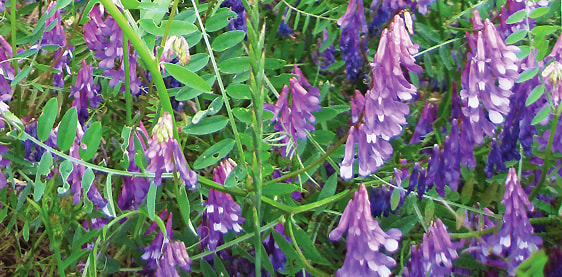|
Cover crops are a confusing topic for most gardeners, and no wonder. Most books expect you to plow them under. To gardeners, that doesn't sound doable. But new research shows that soil-building comes easier than that: from roots.
Of course, the top growth is important; preventing weeds alone is a huge benefit. And preventing soil loss. But out of sight, the roots do much more. Like opening passages for oxygen, feeding earthworms--and dying. When the tops are cut, the roots die and turn to compost right there in the soil. Compost that you don't have to haul, turn, or shovel. And we aren't talking small amounts here. Winter Rye makes 380 miles of roots per plant. The most fertile soils in the world are grasslands, where the roots grow and die in the soil year after year. Turns out that the buffalo enriched the soil in an unexpected way-- "pulse grazing." They chewed the tops off, and the roots died back. The animals migrated away, the tops grew back, and the cycle repeated. In your garden, you are the buffalo! What to Plant? Let Nature be your guide. Meadows and prairies have a mixture of grasses, legumes, flowers, and taprooted plants. The famously fertile topsoils of the Midwest were built by such plant communities. Use that soil-building synergy in your garden. Your mix should include:
https://www.quailseeds.com/store/c49/Fertility-Building_Cover_Crops.html Timing is important The size of the root system depends on when you plant. It's best to sow cover crops 2-4 weeks before your first fall frost. * Don't be surprised if the plants don't get tall--they will be busy underground. In tests, crimson clover that was was only 2 inches tall by November nevertheless had roots 12 inches deep, with many nitrogen nodules already fertilizing the soil. Rye only 6 inches tall had roots 20 inches deep. All winter, the roots will be holding your soil, providing channels for water absorption, and adding tons of organic matter to your garden. But how can you plant cover crops when the beds are still full of summer plants? Here are some options:
Don't forget pots and containers. A low-growing, cover crop prevents your expensive soil mix from getting washed away or taken over by weeds. Calendula, poppies, salad greens, clover, and peas are great for this. Bee's Friend will be a cover crop all winter and make lovely flowers in spring. If you aren't sowing in the pot, cover it with its saucer to keep weeds out. See the possibilities for cover crops here: https://www.quailseeds.com/store/c49/Fertility-Building_Cover_Crops.html *You can find first and last frost dates online. Here is one place: https://www.almanac.com/gardening/frostdates
3 Comments
9/12/2021 06:04:41 am
That is good info about NOT having to till under a cover crop. It's just not doable for us small farmers/gardeners. Also the mention of under sowing is good. I am in Southern Oregon with red clay soil. Badly compacted - planted Daikon radish as part of a cover crop last year. Half of the radish grows up above the soil as it can't penetrate any deeper! LOL.
Reply
10/17/2021 06:22:54 am
Great post. I've read some blogs about cover crops and its advantages and disadvantages. And your post is added on my list. Thank you for sharing!
Reply
Shana Byrne
9/20/2022 06:07:28 am
Thanks for the encouragement and for sharing this information.
Reply
Leave a Reply. |
AuthorJamie Chevalier lives and gardens on a river in the Coast Range of Northern California. She has gardened professionally in Alaska and California, as well as living in a remote cabin, commercial fishing, and working with seeds. She is the proprietor of Quail Seeds. Archives
July 2024
|
- Home
-
Shop
- Plant for Summer
-
Vegetable Seeds
>
- Arugula
- Beans
- Beets
- Broccoli and Cima di Rapa
- Cabbage
- Carrots & Roots
- Celery
- Chard
- Corn
- Cucumber
- Eggplant
- Fennel
- Genepools and Landrace Gardening
- Greens
- Kale and Collards
- Lettuce
- Melons
- Oil Crops
- Okra
- Open-Source Seeds (OSSI)
- Onions and Leeks
- Peas
- Peppers
- Spinach
- Squash & Pumpkins
- Sunflowers
- Tomatoes
- Tomatillos/Husk Cherries
- Turnips and Rutabagas
- Perennial Vegetables >
- Flower Seeds
- Herb Seeds >
- Seed Collections
- Pollinator and Pest Control Plants >
- Grains >
- Cover Crops >
- Open Source (OSSI)
- Start these Indoors
- People behind the Seeds >
- Companion Plants
- Recipes >
- Fast, Fresh Food
- Plant for Spring >
- Plant for Fall >
- About Us.
- Blog
- HOW-TO
- Mid-to-Late Summer Sowings
Proudly powered by Weebly
- Home
-
Shop
- Plant for Summer
-
Vegetable Seeds
>
- Arugula
- Beans
- Beets
- Broccoli and Cima di Rapa
- Cabbage
- Carrots & Roots
- Celery
- Chard
- Corn
- Cucumber
- Eggplant
- Fennel
- Genepools and Landrace Gardening
- Greens
- Kale and Collards
- Lettuce
- Melons
- Oil Crops
- Okra
- Open-Source Seeds (OSSI)
- Onions and Leeks
- Peas
- Peppers
- Spinach
- Squash & Pumpkins
- Sunflowers
- Tomatoes
- Tomatillos/Husk Cherries
- Turnips and Rutabagas
- Perennial Vegetables >
- Flower Seeds
- Herb Seeds >
- Seed Collections
- Pollinator and Pest Control Plants >
- Grains >
- Cover Crops >
- Open Source (OSSI)
- Start these Indoors
- People behind the Seeds >
- Companion Plants
- Recipes >
- Fast, Fresh Food
- Plant for Spring >
- Plant for Fall >
- About Us.
- Blog
- HOW-TO
- Mid-to-Late Summer Sowings


 RSS Feed
RSS Feed